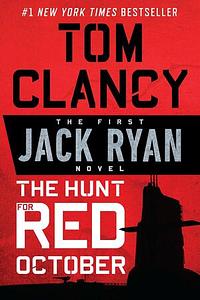Take a photo of a barcode or cover
adventurous
informative
tense
medium-paced
Strong character development:
No
Loveable characters:
N/A
Diverse cast of characters:
No
Flaws of characters a main focus:
No
When I joined the U.S. Navy this was the first book that I read when I completed Bootcamp. As a result of reading Hunt for Red October, I signed up for submarine duty. It is not an understatement for me to say that this story changed my life. I have never regretted the decision to join subs.
As for the story, it follows the Soviet submarine Red October as it leaves port and tries to travel the distance from the north Atlantic to the U.S. coast undetected. The Captain is a senior and seasoned professional that knows the methods of both the Soviets and the U.S. What he hasn't planned for is the submarine USS Dallas and her extraordinary crew who discover how to track the un-trackable sub.
This story also introduces Jack Ryan, who is a main character for Tom Clancy. In this story Ryan is a analyst for the CIA and he figures out what the Red October is unto and is key to helping execute the final plan. Without giving any spoilers, it is enough to say that this the Clancy thriller that started it all for Jack Ryan and even Clancy.
Recommend this story to all Clancy fans!
As for the story, it follows the Soviet submarine Red October as it leaves port and tries to travel the distance from the north Atlantic to the U.S. coast undetected. The Captain is a senior and seasoned professional that knows the methods of both the Soviets and the U.S. What he hasn't planned for is the submarine USS Dallas and her extraordinary crew who discover how to track the un-trackable sub.
This story also introduces Jack Ryan, who is a main character for Tom Clancy. In this story Ryan is a analyst for the CIA and he figures out what the Red October is unto and is key to helping execute the final plan. Without giving any spoilers, it is enough to say that this the Clancy thriller that started it all for Jack Ryan and even Clancy.
Recommend this story to all Clancy fans!
Tom Clancy owned an insurance agency and wrote in his spare time in the early 1980s. Among his output were articles for the non-profit United States Naval Institute journal Proceedings and eventually, a technically detailed spy thriller about a Russian submarine captain who wants to defect and the CIA analyst who helps shepherd him in, along with his submarine. When no publisher showed interest in the novel, a USNI Press editor suggested her company buy it, because it had the potential to be very big.
The company listened, the USNI Press published its first fiction work ever and so in 1984 The Hunt for Red October, the character Jack Ryan and Clancy all became famous. A thumbs-up from President Ronald Reagan, who regarded the Cold War tale as "the best yarn," didn't hurt.
It's easy to look at Clancy's later work, bloated by a lack of editing and weighed down by his comically inept handling of anything other than an action scene or technical description, and forget that one of the reasons he became a household name was because October really is a great story and pretty well told. As he unspools Marko Ramius' plot to defect and give the Americans the brand-new Red October submarine with its secret super-silent engine, Clancy maintains suspense across an ocean-wide stage and multiple scenes. Both Ramius and Ryan are well-developed and realistic characters, featuring a level of introspection about their work that Clancy allowed to ebb away over the course of the series.
Clancy also shows what an incident like this could mean in the real world of the Cold War -- as Soviet ships hunt the U.S.-bound Red October, they risk confrontations with American forces in a time where it wouldn't have taken too many mistakes for the two nations to begin direct conflict. And naturally there are the technical details of weapons systems and operations that reportedly earned Clancy attention from military officials worried that someone had compromised secret information. He does go overboard with some of these, and he probably has a few too many "brush with Armageddon" scenes -- the screenwriters for the 1990 movie adaptation slimmed the story down considerably but their movie shows how good it is at its base.
October is often cited as beginning a wave of "techno-thrillers," or highly detailed and accurately described spy and thriller novels. Techno-thrillers existed well before it, though (just ask Clive Cussler), and you could make a case that Herman Melville's Moby-Dick, which salts is narrative quite liberally with precise and detailed descriptions of 19th-century whaling techniques, was the real genesis of the format.
Of course, Clancy is no Melville, October is no Moby-Dick and subsequent Ryan thrillers went from tedious to omissable to unreadable. But if the latter is really one of the top candidates for "the Great American Novel" as it's often described, then October can lay a solid claim to being the Pretty Good American Novel in its own right.
Original available here.
The company listened, the USNI Press published its first fiction work ever and so in 1984 The Hunt for Red October, the character Jack Ryan and Clancy all became famous. A thumbs-up from President Ronald Reagan, who regarded the Cold War tale as "the best yarn," didn't hurt.
It's easy to look at Clancy's later work, bloated by a lack of editing and weighed down by his comically inept handling of anything other than an action scene or technical description, and forget that one of the reasons he became a household name was because October really is a great story and pretty well told. As he unspools Marko Ramius' plot to defect and give the Americans the brand-new Red October submarine with its secret super-silent engine, Clancy maintains suspense across an ocean-wide stage and multiple scenes. Both Ramius and Ryan are well-developed and realistic characters, featuring a level of introspection about their work that Clancy allowed to ebb away over the course of the series.
Clancy also shows what an incident like this could mean in the real world of the Cold War -- as Soviet ships hunt the U.S.-bound Red October, they risk confrontations with American forces in a time where it wouldn't have taken too many mistakes for the two nations to begin direct conflict. And naturally there are the technical details of weapons systems and operations that reportedly earned Clancy attention from military officials worried that someone had compromised secret information. He does go overboard with some of these, and he probably has a few too many "brush with Armageddon" scenes -- the screenwriters for the 1990 movie adaptation slimmed the story down considerably but their movie shows how good it is at its base.
October is often cited as beginning a wave of "techno-thrillers," or highly detailed and accurately described spy and thriller novels. Techno-thrillers existed well before it, though (just ask Clive Cussler), and you could make a case that Herman Melville's Moby-Dick, which salts is narrative quite liberally with precise and detailed descriptions of 19th-century whaling techniques, was the real genesis of the format.
Of course, Clancy is no Melville, October is no Moby-Dick and subsequent Ryan thrillers went from tedious to omissable to unreadable. But if the latter is really one of the top candidates for "the Great American Novel" as it's often described, then October can lay a solid claim to being the Pretty Good American Novel in its own right.
Original available here.
I'll do the same review for all Clancy's novels because they're all pretty much the same. Very long, very detailed, and after a while, very repetitive. If you stop after just a few of his books you'd probably give them 4 or 5 stars, but beyond that they start to grate. Especially where Jack Ryan is involved. I mean, Clancy spends hundreds of pages getting his details just right, the settings perfect etc., then he has Ryan dodging more bullets than James Bond! I finally threw my hands up and surrendered when Ryan becomes President. I can't remember what piece of crap that was in.
I've given three stars as a compromise between my reactions when reading my first Clancy (brilliant) and last Clancy (doorstop).
I've given three stars as a compromise between my reactions when reading my first Clancy (brilliant) and last Clancy (doorstop).
Silently, beneath the chill Atlantic waters, Russia’s ultra-secret missile submarine, the Red October, is heading west. The Americans want her. The Russians want her back.
adventurous
emotional
mysterious
medium-paced
Strong character development:
No
Loveable characters:
Complicated
Diverse cast of characters:
No
Flaws of characters a main focus:
Yes
adventurous
challenging
informative
tense
slow-paced
Strong character development:
Yes
Loveable characters:
No
Diverse cast of characters:
Yes
Flaws of characters a main focus:
Yes
adventurous
mysterious
tense
fast-paced
Plot or Character Driven:
Plot
Strong character development:
Yes
Loveable characters:
N/A
Diverse cast of characters:
No
When the biggest, baddest Russian submarine goes missing due to its officers having a plan of their own, the Russian government is forced to spring into action to prevent the Americans from getting their hands on the advanced technologies contained within the billion dollar submarine. Once the Americans get wind of a missing submarine, The Hunt for Red October is set. Up to this point my main experience with Tom Clancy was the many video games containing his nomenclature. I started reading, hoping for an interesting tale of political and military intrigue and I was not disappointed.
The level of detail in the elements that make up this plot is extraordinary. In a lot of ways, this made the story richer and more dense. In some portions of the book, it did get a little bit dragged down by so many moving pieces that occasionally plodded instead of engaged. New names and characters are constantly introduced and keeping everything straight, along with the massive amount of military terminology, was no small task -- albeit a rewarding one. With some of the extraneous trimmed, I would say the book would be even better.
I greatly enjoyed this story overall. It was a very different sort of read for me -- one that challenged me in a positive way. In the future I do plan on reading more of the Jack Ryan series. I am all in for more complex stories of behind-the-scenes government conspiracies. While I thought there was a bit too much expositional knowledge forced on the reader here, I still came away greatly enjoying what was offered.
The level of detail in the elements that make up this plot is extraordinary. In a lot of ways, this made the story richer and more dense. In some portions of the book, it did get a little bit dragged down by so many moving pieces that occasionally plodded instead of engaged. New names and characters are constantly introduced and keeping everything straight, along with the massive amount of military terminology, was no small task -- albeit a rewarding one. With some of the extraneous trimmed, I would say the book would be even better.
I greatly enjoyed this story overall. It was a very different sort of read for me -- one that challenged me in a positive way. In the future I do plan on reading more of the Jack Ryan series. I am all in for more complex stories of behind-the-scenes government conspiracies. While I thought there was a bit too much expositional knowledge forced on the reader here, I still came away greatly enjoying what was offered.
Based on the 1975 attempted defection of a Soviet destroyer. A Soviet submarine captain defects with his crew...without the Soviets realizing it. Russia's navy has orders to destroy the sub while the American navy has orders to find it and get the sub to an American port. Lots of techno-jargon. The movie is excellent but the book is a bit different and fills in some holes in the plot.




